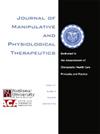Utilization of Chiropractic Care at The World Games 2017: A Retrospective Descriptive Study
IF 1.4
4区 医学
Q4 HEALTH CARE SCIENCES & SERVICES
Journal of Manipulative and Physiological Therapeutics
Pub Date : 2023-06-01
DOI:10.1016/j.jmpt.2024.03.001
引用次数: 0
Abstract
Objective
The purpose of this study was to report utilization of chiropractic care during The World Games 2017 in Wroclaw, Poland.
Methods
A retrospective analysis was performed on treatment records. Thirty-five chiropractors trained in sports injuries provided care for athletes and non-athletes (support personnel) who voluntarily sought chiropractic care. Data included demographics (age, sex, role, country, and sport), category of anatomical regions treated, treatment modality (manipulation, myotherapy, mobilization, taping, and other), and participants’ self-reported pain ratings.
Results
A total of 1902 completed treatment forms representing 1902 encounters were included for athletes (n = 1238, 65%) and non-athletes (n = 664, 35%). There were 9385 individuals (athlete or non-athlete). Five hundred ninety of 3666 (16%) athletes and 422 of 5719 (7%) non-athletes received chiropractic treatment. Athletes represented 28 of 31 (90%) sports and 79 of 108 (73%) countries present. The thoracic spine was the most frequently treated spinal region (n = 846, 44%), followed by lumbar spine (n = 831, 44%) and cervical spine (n = 725, 38%). Frequency of treatment modalities was manipulation (n = 1610, 82%), myotherapy (n = 1522, 80%), mobilization (n = 607, 32%), and taping (n = 380, 20%). Acute injuries were more prevalent for athletes (61%) than non-athletes (35%), and athletes sought follow-up care (54%) more than non-athletes (36%). Overall, 89% of participants reported pain reduction immediately after treatment.
Conclusion
This article describes chiropractic care utilization at a multisport event as part of a health care team. The range of treatments included manipulation myotherapy, mobilization, and taping. Although a minority of athletes and non-athletes received chiropractic treatment, many participants reported pain reduction immediately after treatment.
2017 年世界运动会脊骨神经治疗的使用情况:回顾性描述研究
研究目的本研究旨在报告 2017 年波兰弗罗茨瓦夫世界运动会期间脊骨神经治疗的使用情况:对治疗记录进行了回顾性分析。35名接受过运动损伤培训的脊骨神经科医生为自愿寻求脊骨神经科治疗的运动员和非运动员(辅助人员)提供了治疗。数据包括人口统计学特征(年龄、性别、角色、国家和运动项目)、治疗的解剖区域类别、治疗方式(手法、肌力疗法、动员、拍打和其他)以及参与者的自我疼痛评级:运动员(1238 人,占 65%)和非运动员(664 人,占 35%)共填写了 1902 份治疗表,代表 1902 次治疗。共有 9385 人(运动员或非运动员)。3666名运动员中有590人(16%)接受了脊骨神经治疗,5719名非运动员中有422人(7%)接受了脊骨神经治疗。运动员代表了 31 个运动项目中的 28 个(90%)和 108 个国家中的 79 个(73%)。胸椎是最常接受治疗的脊柱区域(846人,44%),其次是腰椎(831人,44%)和颈椎(725人,38%)。治疗方式的频率为手法治疗(n = 1610,82%)、肌力治疗(n = 1522,80%)、动员(n = 607,32%)和绑带(n = 380,20%)。急性损伤在运动员中的发生率(61%)高于非运动员(35%),运动员寻求后续治疗的比例(54%)高于非运动员(36%)。总体而言,89%的参与者表示治疗后疼痛立即减轻:本文介绍了脊骨神经科治疗作为医疗团队的一部分在一项综合性运动会中的应用情况。治疗范围包括手法肌力疗法、动员疗法和拍打疗法。虽然只有少数运动员和非运动员接受了脊骨神经治疗,但许多参与者表示治疗后疼痛立即减轻。
本文章由计算机程序翻译,如有差异,请以英文原文为准。
求助全文
约1分钟内获得全文
求助全文
来源期刊
CiteScore
3.00
自引率
7.70%
发文量
63
审稿时长
29 weeks
期刊介绍:
The Journal of Manipulative and Physiological Therapeutics (JMPT) is an international and interdisciplinary journal dedicated to the advancement of conservative health care principles and practices. The JMPT is the premier biomedical publication in the chiropractic profession and publishes peer reviewed, research articles and the Journal''s editorial board includes leading researchers from around the world.
The Journal publishes original primary research and review articles of the highest quality in relevant topic areas. The JMPT addresses practitioners and researchers needs by adding to their clinical and basic science knowledge and by informing them about relevant issues that influence health care practices.

 求助内容:
求助内容: 应助结果提醒方式:
应助结果提醒方式:


